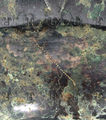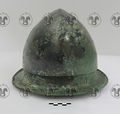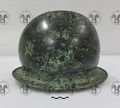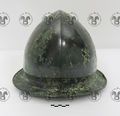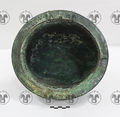SL-1 helmet: Difference between revisions
Sindy Kluge (talk | contribs) No edit summary |
|||
| (6 intermediate revisions by 3 users not shown) | |||
| Line 1: | Line 1: | ||
{{object | {{object | ||
|name= | |name=Vače helmet | ||
|type_object=helmet | |type_object=helmet | ||
|type=Negau helmet, Slovenian type, variant Vače | |type=Negau helmet, Slovenian type, variant Vače | ||
|material=bronze | |material=bronze | ||
|dimension= | |dimension=length: 27 cm, width: 25.8 cm, height: 19 cm, thickness: 1 mm | ||
|dimension_max=27. | |dimension_max=27.0 cm | ||
|condition=complete | |condition=complete | ||
|sortdate=-425 | |sortdate=-425 | ||
|date=second half of the | |date=second half of the 5<sup>th</sup> century BC | ||
|date_derivation=typology | |date_derivation=typology | ||
|site=Vače | |site=Vače | ||
|find_circumstances=unknown | |find_circumstances=unknown | ||
|date_find=before | |date_find=before 1883 | ||
|location=Kunsthistorisches Museum Wien – Antikensammlung | |location=Kunsthistorisches Museum Wien – Antikensammlung | ||
|inventory_number=VI 2655 | |inventory_number=VI 2655 | ||
|accessibility=repository | |accessibility=repository | ||
|checklevel=0 | |||
|checklevel= | |||
}} | }} | ||
== Commentary == | == Commentary == | ||
Bronze Negau | First published in {{bib|Schneider 1892}}: 54 f. (Nr 97). Examined by TIR on 12<sup>th</sup> February 2014. | ||
Images in {{bib|Egg 1986}}: pl. 249 (photo) and {{bib|Nedoma 1995}}: Abb. 21 (photo). | |||
Bronze Negau helmet of the Slovenian type, variant Vače. Domed bowl with median ridge; crimped brim with lining plate with tube-shaped chin strap bails. The lining plate was riveted together in one place in the back (the two rivets are still visible) and is perforated at regular intervals along the inner rim. Patina from light green to dark green in colour with patches from light brown to white in colour. Corrosion with some slivers; few other traces of abrasion. Slight dent on the left-side outer rim of the brim, which is slightly broken in this place. The only decoration is stamped all around on the lining plate: a row of palmettes and one of spiral eyes between three thin lines which frame and separate them. Cf. {{bib|Egg 1986}}: 228 (no. 330). | |||
The inscription [[index::SL-1]] is applied in front on the chamfer. Embossed marks are applied in two more places: an oblique line {{c||line d 2}} (height 1.5 cm) is embossed with a pointed tool (about thirty indentations) at the back on the chamfer. The same mark is found in the exact same place on another Negau-type helmet ([[index::Kunsthistorisches Museum Wien – Antikensammlung]], inv. No. VI 1668), but embossed with an oblong tool ({{bib|Marstrander 1927}}: 14 f., 20). Another mark {{c||line d 2}} {{c||line d 1}} (height 0.6 cm) is embossed on the edge of the dome right above the chamfer and the oblique line. | |||
The attribution of the helmet to the variant Vače is based on the tube-shaped bails which are characteristic of this variant ({{bib|Egg 1986}}: 68); the helmet can be further classified as belonging to the subtype with spiral-eye decoration. The area of production cannot be precisely determined, but is likely closer to the Alpine region than the find place. For typology, distribution and the dating to the mid-5<sup>th</sup>–early 4<sup>th</sup> century see {{bib|Egg 1986}}: 68, 78–82 and {{bib|Urban & Nedoma 2002}}: 52–54. | |||
The good state of preservation of the helmet, with no evidence of intentional damage, indicates that it was not ritually deposited like the helmets of the [[index::Ženjak]] hoard ({{bib|Nedoma 1995}}: 33). | |||
The exact find place of the helmet is unknown. It was purchased between 1880 and 1891 for the [[index::Kunsthistorisches Museum Wien – Antikensammlung|Antikensammlung]] in Vienna from one Johann Grilz (Janez Grilc) from Klenik, a village about a kilometre east of Vače. {{bib|Schneider 1892}}: 55 notes "Aus Watsch in Krain 1883.", which is probably the year of acquisition. {{bib|Reinecke 1950}}: 145 mentions an attached document at the museum, dated to 10 July 1886, which records that the helmet was part of a number of antiquities which were sold by Grilz to the museum, but this is likely a later memo, as the writer seems to have only second-hand information about these additional objects ("angeblich"). Grilz, a local farmer, appears to have been an avid collector and seller of archaeological finds; he also discovered the Situla of Vače in January or March 1882 (sold to the museum in Ljubljana). | |||
Despite its good condition and well legible inscription, the helmet is currently kept in the depot of the [[index::Kunsthistorisches Museum Wien – Antikensammlung|Kunsthistorisches Museum]], the Negau-helmet showcase being reserved to helmets from the [[index::Ženjak]] hoard. | |||
{{bibliography}} | {{bibliography}} | ||
Latest revision as of 00:27, 17 April 2020
| Object | |
|---|---|
| Proper name: | Vače helmet |
| Classification: | helmet |
| Archaeological type: | Negau helmet, Slovenian type, variant Vače |
| Material: | bronze |
| Size: | length: 27 cm, width: 25.8 cm, height: 19 cm, thickness: 1 mm |
| Condition: | complete |
| Date: | second half of the 5th century BC |
| Date derived from: | typology |
|
| |
| Site: | Vače (Litija, Slovenia) |
| Coordinates (approx.): | 46° 7' 8.40" N, 14° 50' 16.80" E [from site] |
| Find date: | before 1883 |
| Find circumstances: | unknown |
| Current location: | Kunsthistorisches Museum Wien – Antikensammlung (repository) |
| Inventory Nr.: | VI 2655 |
|
| |
| Inscription: | SL-1 (terisna) |
Images
|
Object SL-1 helmet - detail rear side.
|
Object SL-1 helmet - detail rear side.
|
Object SL-1 helmet with inscription SL-1 - front side.
|
Object SL-1 helmet - sideview.
|
Object SL-1 helmet - rear side.
|
|
Object SL-1 helmet - underside.
|
Object SL-1 helmet - detail of the brim.
|
Object SL-1 helmet - detail of the brim.
|
Commentary
First published in Schneider 1892: 54 f. (Nr 97). Examined by TIR on 12th February 2014.
Images in Egg 1986: pl. 249 (photo) and Nedoma 1995: Abb. 21 (photo).
Bronze Negau helmet of the Slovenian type, variant Vače. Domed bowl with median ridge; crimped brim with lining plate with tube-shaped chin strap bails. The lining plate was riveted together in one place in the back (the two rivets are still visible) and is perforated at regular intervals along the inner rim. Patina from light green to dark green in colour with patches from light brown to white in colour. Corrosion with some slivers; few other traces of abrasion. Slight dent on the left-side outer rim of the brim, which is slightly broken in this place. The only decoration is stamped all around on the lining plate: a row of palmettes and one of spiral eyes between three thin lines which frame and separate them. Cf. Egg 1986: 228 (no. 330).
The inscription SL-1 is applied in front on the chamfer. Embossed marks are applied in two more places: an oblique line ![]() (height 1.5 cm) is embossed with a pointed tool (about thirty indentations) at the back on the chamfer. The same mark is found in the exact same place on another Negau-type helmet (Kunsthistorisches Museum Wien – Antikensammlung, inv. No. VI 1668), but embossed with an oblong tool (Marstrander 1927: 14 f., 20). Another mark
(height 1.5 cm) is embossed with a pointed tool (about thirty indentations) at the back on the chamfer. The same mark is found in the exact same place on another Negau-type helmet (Kunsthistorisches Museum Wien – Antikensammlung, inv. No. VI 1668), but embossed with an oblong tool (Marstrander 1927: 14 f., 20). Another mark ![]()
![]() (height 0.6 cm) is embossed on the edge of the dome right above the chamfer and the oblique line.
(height 0.6 cm) is embossed on the edge of the dome right above the chamfer and the oblique line.
The attribution of the helmet to the variant Vače is based on the tube-shaped bails which are characteristic of this variant (Egg 1986: 68); the helmet can be further classified as belonging to the subtype with spiral-eye decoration. The area of production cannot be precisely determined, but is likely closer to the Alpine region than the find place. For typology, distribution and the dating to the mid-5th–early 4th century see Egg 1986: 68, 78–82 and Urban & Nedoma 2002: 52–54.
The good state of preservation of the helmet, with no evidence of intentional damage, indicates that it was not ritually deposited like the helmets of the Ženjak hoard (Nedoma 1995: 33).
The exact find place of the helmet is unknown. It was purchased between 1880 and 1891 for the Antikensammlung in Vienna from one Johann Grilz (Janez Grilc) from Klenik, a village about a kilometre east of Vače. Schneider 1892: 55 notes "Aus Watsch in Krain 1883.", which is probably the year of acquisition. Reinecke 1950: 145 mentions an attached document at the museum, dated to 10 July 1886, which records that the helmet was part of a number of antiquities which were sold by Grilz to the museum, but this is likely a later memo, as the writer seems to have only second-hand information about these additional objects ("angeblich"). Grilz, a local farmer, appears to have been an avid collector and seller of archaeological finds; he also discovered the Situla of Vače in January or March 1882 (sold to the museum in Ljubljana).
Despite its good condition and well legible inscription, the helmet is currently kept in the depot of the Kunsthistorisches Museum, the Negau-helmet showcase being reserved to helmets from the Ženjak hoard.
Bibliography
| Egg 1986 | Markus Egg, Italische Helme. Studien zu den ältereisenzeitlichen Helmen Italiens und der Alpen. Teil 1: Text, Teil 2: Tafeln, Mainz: Römisch-Germanisches Zentralmuseum 1986. |
|---|---|
| Marstrander 1927 | Carl Johan Sverdrup Marstrander, "Remarques sur les inscriptions des casques en bronze de Negau et de Watsch", Avhandlinger utgitt av Det Norske Videnskaps-Akademi i Oslo. Hist.-filos. klasse 1926/2 (1927), 1–26. |
